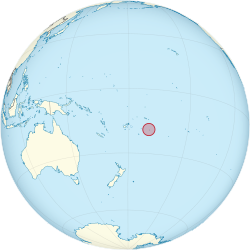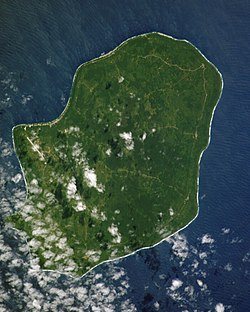
Back Niue ACE Niue Afrikaans Niue ALS ኒዌ Amharic Niue AN नीउए ANP نييوي Arabic نيواى ARZ Niue AST Niuea AVK
Niue Niuē (Niuean) | |
|---|---|
| Motto: Atua, Niue Tukulagi (Niuean) "God, Niue Eternally" | |
| Anthem: Ko e Iki he Lagi (Niuean) "The Lord in Heaven" | |
 | |
 Satellite image of Niue | |
| Capital and largest village | Alofi 19°03′14″S 169°55′12″W / 19.05389°S 169.92000°W |
| Official languages | |
| Ethnic groups |
|
| Religion | |
| Demonym(s) | Niuean |
| Government | Unitary non-partisan parliamentary constitutional monarchy |
• Monarch | Charles III |
| Dame Cindy Kiro | |
| Dalton Tagelagi | |
| Legislature | Niue Assembly |
| Associated state of New Zealand | |
• Self-government in free association with New Zealand | 19 October 1974 |
| 1994 | |
| Area | |
• Total | 261.46[6] km2 (100.95 sq mi) |
• Water (%) | negligible |
| Population | |
• 2021 estimate | 1,937[7][8] (not ranked) |
• 2022 census | 1,681[9] |
• Density | 6.71/km2 (17.4/sq mi) (not ranked) |
| GDP (PPP) | 2003 estimate |
• Total | $10.0 million[10] (228th) |
• Per capita | $5,800[11] (164th) |
| GDP (nominal) | 2021 estimate |
• Total | |
| Currency | New Zealand dollar[a] (NZD) |
| Time zone | UTC−11 |
| Drives on | Left |
| Calling code | +683 |
| ISO 3166 code | NU |
| Internet TLD | .nu |
| |
Niue (/ˈnjuːeɪ/ ⓘ,[13] /niːˈjuːeɪ/; Niuean: Niuē) is a self-governing island country in free association with New Zealand. It is situated in the South Pacific Ocean and is part of Polynesia, and predominantly inhabited by Polynesians. One of the world's largest coral islands, Niue is commonly referred to as "The Rock", which comes from the traditional name "Rock of Polynesia".[14]
Niue's position is inside a triangle drawn between Tonga, Samoa, and the Cook Islands. It is 2,400 kilometres (1,500 mi) northeast of New Zealand, and 604 kilometres (375 mi) northeast of Tonga. Niue's land area is about 261.46 square kilometres (100.95 sq mi)[6] and its population was 1,689 at the Census in 2022.
The terrain of the island has two noticeable levels. The higher level is made up of a limestone cliff running along the coast, with a plateau in the centre of the island reaching approximately 60 metres (200 ft) above sea level. The lower level is a coastal terrace approximately 0.5 km (0.3 miles) wide and about 25–27 metres (80–90 feet) high, which slopes down and meets the sea in small cliffs. A coral reef surrounds the island, with the only major break in the reef being in the central western coast, close to the capital, Alofi.
Niue is subdivided into 14 villages (municipalities). Each village has a council that elects its chairperson, and are also electoral districts, and send an assemblyperson to the Niue Assembly (parliament).[15]
As part of the Realm of New Zealand, New Zealand conducts most diplomatic relations on behalf of Niue. Niueans are citizens of New Zealand and Charles III is Niue's head of state in his capacity as King of New Zealand. Between 90% and 95% of Niuean people live in New Zealand,[16] along with about 70% of the speakers of the Niuean language.[17] Niue is a bilingual country, with 30% of the population speaking both Niuean and English. The percentage of monolingual English-speaking people is 11%, while 46% are monolingual Niuean speakers.
Niue is a parliamentary democracy, with legislative elections every three years. Niue is not a member of the United Nations (UN), but UN organisations have accepted its status as a freely associated state as equivalent to independence for the purposes of international law.[18] As such, Niue is a member of some UN specialised agencies (such as UNESCO[19] and the WHO),[20] and is invited, alongside the other non-UN member state, the Cook Islands, to attend United Nations conferences open to "all states".[21] Niue has been a member of the Pacific Community since 1980.
- ^ TheCoconetTV. The National Anthem of Niue 'Ki Niue Nei'. YouTube. Retrieved 24 August 2023.
- ^ "Religions in Niue | PEW-GRF". www.globalreligiousfutures.org. Archived from the original on 14 December 2021. Retrieved 2 August 2020.
- ^ "Niue National Strategic Plan 2016–2026" (PDF). Government of Niue. 2016. p. 35.
- ^ "The World today" (PDF). UN.
- ^ "Repertory of Practice – Organs Supplement" (PDF). UN. p. 10. Archived from the original (PDF) on 19 October 2013.
- ^ a b "Niue". GeoHive. Archived from the original on 6 October 2013. Retrieved 5 October 2013.
- ^ "World Population Prospects 2022". United Nations Department of Economic and Social Affairs, Population Division. Retrieved 17 July 2022.
- ^ "World Population Prospects 2022: Demographic indicators by region, subregion and country, annually for 1950-2100" (XSLX) ("Total Population, as of 1 July (thousands)"). United Nations Department of Economic and Social Affairs, Population Division. Retrieved 17 July 2022.
- ^ "Niue Household and Population Census 2022" (PDF). niue.prism.spc.int. Niue Statistics Office. Retrieved 5 May 2020.
- ^ "The World Factbook – Central Intelligence Agency". cia.gov. Archived from the original on 4 June 2011. Retrieved 8 September 2017.
- ^ "The World Factbook – Central Intelligence Agency". cia.gov. Archived from the original on 24 April 2013. Retrieved 8 September 2017.
- ^ "Niue National Accounts estimates". niue.prism.spc.int. Niue Statistics Office. Retrieved 5 May 2020.
- ^ Deverson, Tony; Kennedy, Graeme, eds. (2005). "Niue". The New Zealand Oxford Dictionary. Oxford University Press. doi:10.1093/acref/9780195584516.001.0001. ISBN 978-0-19-558451-6. Retrieved 18 February 2022.
- ^ "Introducing Niue". Lonely Planet. Archived from the original on 25 October 2016. Retrieved 24 October 2016.
- ^ "Niue Islands Village Council Ordinance 1967". Archived from the original on 28 December 2016. Retrieved 28 October 2017.
- ^ "QuickStats About Pacific Peoples". Statistics New Zealand. 2006. Archived from the original on 19 November 2011. Retrieved 28 October 2011.
- ^ Moseley, Christopher; R. E. Asher, eds. (1994). Atlas of the World's Languages. New York: Routledge. p. 100.
- ^ "Find a publication". New Zealand Ministry of Justice. Archived from the original on 29 April 2016. Retrieved 25 July 2013.
- ^ "Niue". UNESCO International Bureau of Education.
- ^ "List of member countries". World Health Organization. Archived from the original on 21 August 2004.
- ^ "Pacific Climate Change: Niue urges world leaders to leave legacy of action at climate conference". climatepasifika.blogspot.com.br. 8 December 2011.
Cite error: There are <ref group=lower-alpha> tags or {{efn}} templates on this page, but the references will not show without a {{reflist|group=lower-alpha}} template or {{notelist}} template (see the help page).

